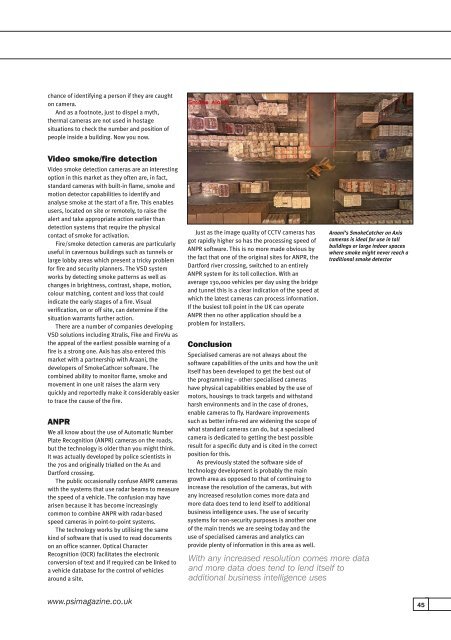PSIMarch2018
Create successful ePaper yourself
Turn your PDF publications into a flip-book with our unique Google optimized e-Paper software.
chance of identifying a person if they are caught<br />
on camera.<br />
And as a footnote, just to dispel a myth,<br />
thermal cameras are not used in hostage<br />
situations to check the number and position of<br />
people inside a building. Now you now.<br />
Video smoke/fire detection<br />
Video smoke detection cameras are an interesting<br />
option in this market as they often are, in fact,<br />
standard cameras with built-in flame, smoke and<br />
motion detector capabilities to identify and<br />
analyse smoke at the start of a fire. This enables<br />
users, located on site or remotely, to raise the<br />
alert and take appropriate action earlier than<br />
detection systems that require the physical<br />
contact of smoke for activation.<br />
Fire/smoke detection cameras are particularly<br />
useful in cavernous buildings such as tunnels or<br />
large lobby areas which present a tricky problem<br />
for fire and security planners. The VSD system<br />
works by detecting smoke patterns as well as<br />
changes in brightness, contrast, shape, motion,<br />
colour matching, content and loss that could<br />
indicate the early stages of a fire. Visual<br />
verification, on or off site, can determine if the<br />
situation warrants further action.<br />
There are a number of companies developing<br />
VSD solutions including Xtralis, Fike and FireVu as<br />
the appeal of the earliest possible warning of a<br />
fire is a strong one. Axis has also entered this<br />
market with a partnership with Araani, the<br />
developers of SmokeCathcer software. The<br />
combined ability to monitor flame, smoke and<br />
movement in one unit raises the alarm very<br />
quickly and reportedly make it considerably easier<br />
to trace the cause of the fire.<br />
ANPR<br />
We all know about the use of Automatic Number<br />
Plate Recognition (ANPR) cameras on the roads,<br />
but the technology is older than you might think.<br />
It was actually developed by police scientists in<br />
the 70s and originally trialled on the A1 and<br />
Dartford crossing.<br />
The public occasionally confuse ANPR cameras<br />
with the systems that use radar beams to measure<br />
the speed of a vehicle. The confusion may have<br />
arisen because it has become increasingly<br />
common to combine ANPR with radar-based<br />
speed cameras in point-to-point systems.<br />
The technology works by utilising the same<br />
kind of software that is used to read documents<br />
on an office scanner. Optical Character<br />
Recognition (OCR) facilitates the electronic<br />
conversion of text and if required can be linked to<br />
a vehicle database for the control of vehicles<br />
around a site.<br />
Just as the image quality of CCTV cameras has<br />
got rapidly higher so has the processing speed of<br />
ANPR software. This is no more made obvious by<br />
the fact that one of the original sites for ANPR, the<br />
Dartford river crossing, switched to an entirely<br />
ANPR system for its toll collection. With an<br />
average 130,000 vehicles per day using the bridge<br />
and tunnel this is a clear indication of the speed at<br />
which the latest cameras can process information.<br />
If the busiest toll point in the UK can operate<br />
ANPR then no other application should be a<br />
problem for installers.<br />
Conclusion<br />
Specialised cameras are not always about the<br />
software capabilities of the units and how the unit<br />
itself has been developed to get the best out of<br />
the programming – other specialised cameras<br />
have physical capabilities enabled by the use of<br />
motors, housings to track targets and withstand<br />
harsh environments and in the case of drones,<br />
enable cameras to fly. Hardware improvements<br />
such as better infra-red are widening the scope of<br />
what standard cameras can do, but a specialised<br />
camera is dedicated to getting the best possible<br />
result for a specific duty and is cited in the correct<br />
position for this.<br />
As previously stated the software side of<br />
technology development is probably the main<br />
growth area as opposed to that of continuing to<br />
increase the resolution of the cameras, but with<br />
any increased resolution comes more data and<br />
more data does tend to lend itself to additional<br />
business intelligence uses. The use of security<br />
systems for non-security purposes is another one<br />
of the main trends we are seeing today and the<br />
use of specialised cameras and analytics can<br />
provide plenty of information in this area as well.<br />
Araani’s SmokeCatcher on Axis<br />
cameras is ideal for use in tall<br />
buildings or large indoor spaces<br />
where smoke might never reach a<br />
traditional smoke detector<br />
With any increased resolution comes more data<br />
and more data does tend to lend itself to<br />
additional business intelligence uses<br />
www.psimagazine.co.uk<br />
45

















